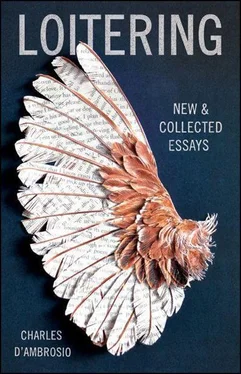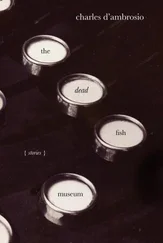Each room in Hell House could be considered a canto in the Commedia , particularly the Inferno , except that the idea of descent in Dante, the funneled shape of hell as you circle down into worse and worse sins, was ditched by Hell House in favor of a cosmologically flat canvas in which all sins were equally bad, and the entire trip instead resembled the morality plays and pageants put on for the feast of Corpus Christi in the fourteenth century. I’m not so much talking about design or construction here as the religious arrangement of sins. In that sense it stepped back from the Renaissance and the availability of perspective into the depthless stage of Everyman in the late Middle Ages. As a moral program, the schema for Hell House was linear, but as a physical structure, as architecture, it was anfractuous, like an intestine, twisting and turning, kinked here and there with knots, and the tour took you not so much down, as toward, an interior. It wasn’t actually a house; it was more like visiting a sin zoo, strolling from room to room, watching the curious habits of fucked-up people. In each of the seven or so rooms you saw a playlet but there was no overall narrative. The entire visit lasted about an hour, but with no plot, no torquing up of the drama, I arrived at the Day of Judgment bored to death.
You were ushered through Hell House by ghouls in skull masks and black capes. Some of the ghouls wore tennis shoes and were obviously adolescent, and their taunting had a certain playground aspect that was really annoying and bratty. There were even some especially short skinny ghouls no older than nine or ten or eleven who, relaxing between acts with their hoods off, came at me and the photographer, as we dawdled behind our group, and told us to go to hell, pointing the way. “Go to hell!” they kept saying, over and over, obviously enjoying a curse that, for the two-week run of Hell House, was officially sanctioned. As the tour went on it became clear to me that these ghouls were quite specifically the voice of conservative values, although at first it had seemed as if they were supposed to incarnate the devil himself. Either way, these kids qua ghouls weren’t giving off a full human vibration.
The tour took you through a variety of rooms, all staged like a theatrical set: the cabin of a jetliner, a rave, a hospital, a garage, a family room, a burial site, a cult sacrifice, a living room, a coffin, heaven, hell, and, before finally releasing you to the cold Dallas night and a cup of hot chocolate at the concession stand, a place to pray and perhaps even convert. Each room held its corresponding sin, the exact nature of which was often elusive. Loosely, you saw drugs plus sex, abortion plus sex, a slumber party plus sex plus murder, a cult sacrifice plus drugs plus murder, porno plus promiscuity plus bastardy plus sodomy plus suicide, and so on — there was a tendency to pile on and the impression was that you couldn’t sin casually or recreationally but had to be hardcore and committed.
The audience watched as a group, from behind a cordon. A few examples should suffice to give a flavor of the whole. The set for the Abortion Scene was a hospital room. A girl in blue scrubs was wheeled in on a gurney, her crotch and thighs garishly soaked in blood. She screamed her head off while a doctor and nurse talked across the gurney, consulting so calmly and in such quiet voices they seemed to belong to another story entirely. Whoever wrote the script hadn’t labored much over their dialogue — they showed no concern. You stared right at the girl’s spread legs — I did, anyway — and that was weird. Her positioning sexualized the moment grotesquely — the bath of blood and the girl’s agonal cries and even her death were an obvious but sick and grossly caricatured loss of virginity. More important, though, the girl’s death was an act of revenge, it was retribution for killing an unborn child. It proved a conservative moral point — all the while she was dying the ghouls leaned over the gurney and ridiculed her.
The Slumber Party Scene involved two girls having a sleepover, listening to Mariah Carey, watching television and talking about what they’d like to be when they grow up. Then a man breaks into the house and abducts one of the girls, taking her to his car for what he calls “fun.” You hear one of the ghouls say: “Don’t you just love the smell of fresh meat?”—which totally threw off the point of view for me. Up to that moment my sympathy had been entirely with the girls, but now the ghoul seemed to be saying that this young woman, hauled off to be raped, had somehow invited the moment, had transgressed, was blameworthy. Suddenly the ghoul was an agent of justice. Why else make this observation about fresh meat? It was creepy. Throughout Hell House it was mostly (sexual) girls who were in jeopardy, owing in part, I suppose, to the stock conventions of horror flicks; the girls’ bodies acted as territory in a disputed moral landscape. In the very next scene, which took place in a roofless structure, semi-outdoors, you see the same girl roped to a joist, her hands tied above her head, while her abductor digs the hole he plans to dump her body in.
In the Porno Scene, we see this slumpy guy on a couch, watching dirty movies. His girlfriend comes home. She tells him she’s pregnant. Then she tells him the child she’s carrying isn’t his; it’s his best friend’s. Then he violently forces some kind of humiliating sex on her. (We segue from the living room to the bedroom by watching a black-and-white video, quite blurry, that suggests rough stuff.) The acting in these skits, by the way, was a mixed bag, ranging from OK to horrible, but many of the girls, when they had to scream, could really belt it out. It was never the scream of a real person in real pain but rather a homage to horror movies. When the boyfriend leaves, the girl curses, giving the very best, full-out scream of the whole tour, rolls on the floor, blasphemously accusing her Bible and God of abandonment, and eventually kills herself, simulating slashed wrists by popping a plastic ampoule of stage blood, quite convincingly, on her arm.
All of this was meant to be hideous and repellent, yet each room offered such a long, prurient, gazing look into the life of degradation that the scenarios often seemed like a spastic reaction against a real desire, a fascination. I see two ways to take this observation. One is: somewhere along the line somebody had to imagine the act of sex, and that’s one of the reasons, I think, that so many of the stories ended in murder — it was a way of punishing the imagination and paying for the fundamentalist sin of passing sympathy. The economy of it was creepy in its efficiency, with the condemnation and dispatch following so swiftly on the lapse or frailty or doubt, never considering, for instance, that promiscuity might be about an ambivalent need for love, or the desire, the stray hope, for something other than nothing — possibilities that would engage the imagination, tempting it. And the other is: no one ever actually imagined any of this and Hell House was, instead, a gathering of clichés whose entelechy was fear and this house, far from being haunted, was in fact a safe refuge from the morally confusing universe out beyond the walls of black plastic. The sins were all childishly obvious, and I was aware, just vaguely, of being catechized. Very often I felt the tour wasn’t about conversion but enlistment, and as such, it was a test of loyalty, with anyone who was the slightest bit recreant banished. Loyalty — in its darkest form, which left so much death as its legacy to the twentieth century — rids the divided self of anxiety and guilt, so that murder smiles. The ghouls in Hell House did a lot of gloating as others suffered.
There was a dispirited familiarity to the rooms, a lack of care about the shabby way things looked. Most of the furniture, I imagine, came from thrift stores, arriving at Hell House pre-saddened by other lives, other misfortunes. Everything lacked an element of choice, the memory of an original moment of hope about how things would be. The interiors were decidedly lower middle-class. The headboard in the porn scene was flimsy, not up to the rigors of a good sodomizing, and the vanity was one of those things that put you in mind of a wedding cake, white and elaborate and frilly, so vestal and princessy you just know heartbreak is in store for any girl still holding on to those misplaced hopes past the age of twelve. Things were sad as gesture, sad as furniture, in a world premised on the idea that appearance is a lie. The percale sheets, the sagging mattress, the framed art on the walls (because art is what a blank wall wants), all of it lacked vitality. The sofa was slouchy and vague as to color and the various easy chairs were worn and soiled and the carpet was the kind that’s already there when you move in, with faint paths turned pale where other people have walked. It was a décor that suggested hope was elsewhere, in another life, and a décor that suggested unseen enemies, the sort of place that feels shameful and mean in a world where the failure to prosper is a sin. Of course, the sets were meant to exist only gesturally, as props, but there was something in the hard literal fact, in their mere presence, that encouraged you to see them in a realistic mode. The dingy and dim rooms made for an atmosphere of sordid involvement — they were meant to indicate a shabby moral state, a despondency — but to me the “sins” did not seem moral so much as economic and aesthetic — a matter of both failed consumption and poor taste. Hopelessness had come to reside in the sofa on the porn set because it would never move again, because time had come for it and stayed, like an intimation of death. You felt nothing would change, that progress was gone and destiny mislaid; what the future held was repetition and sameness. There was a malignancy in this world, but it wasn’t a problem you could blame on the devil. In Hell House it wasn’t sin so much as sadness and despair and heartbreak and misfortune and cluelessness and just every stupid human possibility that was answered with damnation. People pathetically in need of help were shot.
Читать дальше












